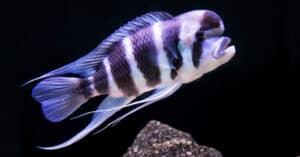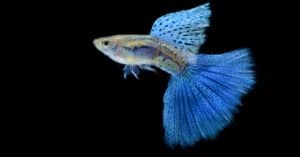The firemouth cichlid is a visually striking aquarium fish beloved among cichlid enthusiasts. It gets its name from the vibrant red colouring along its throat. As with any species of cichlid, there are ways to distinguish between males and females, though some of these ways are subtle. Read on to compare male vs female firemouth cichlids and learn how to tell them apart in a tank environment.
Comparing a Male vs Female Firemouth Cichlid
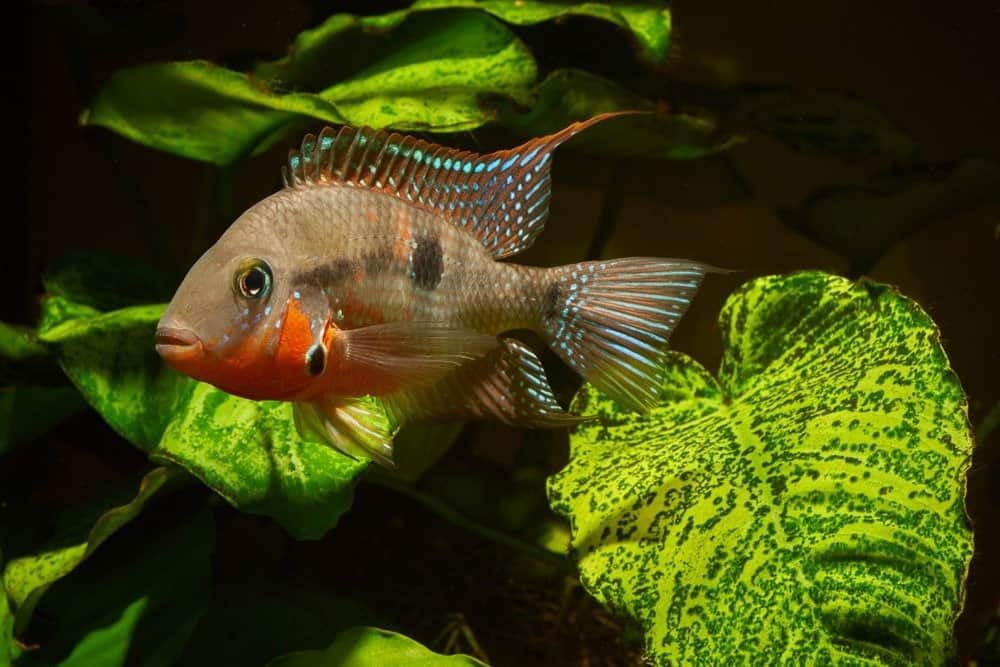
The main differences between male and female firemouth cichlids include size, appearance, colour, reproduction, and behaviour.
©Johannes Menge/Shutterstock.com
The firemouth cichlid is a species of Central American fish belonging to the family Cichlidae. Its scientific name is Thorichthys meeki.
| Male Firemouth Cichlid | Female Firemouth Cichlid | |
|---|---|---|
| Size | 6 inches, 3.5 ounces | 5 inches, 3.5 ounces |
| Appearance | Bright red throat colouration; pointed dorsal and anal fins | Dull red throat colouration; rounded dorsal and anal fins; rounder, larger belly |
| Colour | Bluish-grey body, red throat colouration, black mark on the lower operculum; Generally more vibrantly coloured than females | Bluish-grey body, red throat colouration, black mark on the lower operculum; Generally duller in colour than males |
| Reproduction | Fertilizes eggs, protects eggs and female | Lays eggs, protects eggs |
| Behaviour | Typically peaceful, may be aggressive during spawning | Typically peaceful, may be aggressive during spawning |
The 5 Key Differences Between a Male and a Female Firemouth Cichlid
Firemouth cichlids are sexually dimorphic, meaning there are significant, visible differences between the sexes. Below you will find the 5 key differences between male and female firemouth cichlids including size, appearance, colour, reproduction, and behaviour.
Size
Firemouth cichlids are smaller than most other cichlids, which makes them suitable for most home aquariums. Males are typically larger than females with an average length of 6 inches. Females usually only grow to about 5 inches in length. However, some firemouth cichlids grow bigger under optimal conditions. They only weigh about 3.5 ounces or 99 grams. These fish grow quickly, so it doesn’t take long for juveniles to reach their full adult length and weight.
Appearance

In addition to their bluish-grey bodies and red throats, firemouth cichlids also have black spots on their sides.
Male and female firemouth cichlids differ slightly in appearance. Besides being larger, males tend to have longer, pointed dorsal and anal fins. Females’ fins are shorter and rounder. Both sexes may display red patches along the throat, but in males it is usually brighter, especially during the breeding season. Female genital papillae appear blunter than those of males and their bellies are rounder and larger.
Colour
Besides size, colour is the best way to tell males and females of this species apart. Males are typically more vibrantly coloured than females, especially regarding the red along their throats. Both sexes have a bluish-grey body, though this will also be duller in females. Males and females alike may sport black spots on the lower part of the operculum. Some individuals may even have black bars on their bodies.
Reproduction
Firemouth cichlids need a flat surface to spawn. Once she reaches sexual maturity, a female firemouth cichlid can lay 100-500 eggs at one time. After she lays the eggs, the male fertilizes them. While waiting for the eggs to hatch, the male will be extremely protective of both the eggs and the female. Unlike many fish species, the female mainly cares for the eggs. The eggs should hatch in 3-4 days, after which the fry will swim freely after about a week. The parents will care for them for up to 6 weeks. At the end of this period, the fry will strike out on their own.
Behaviour
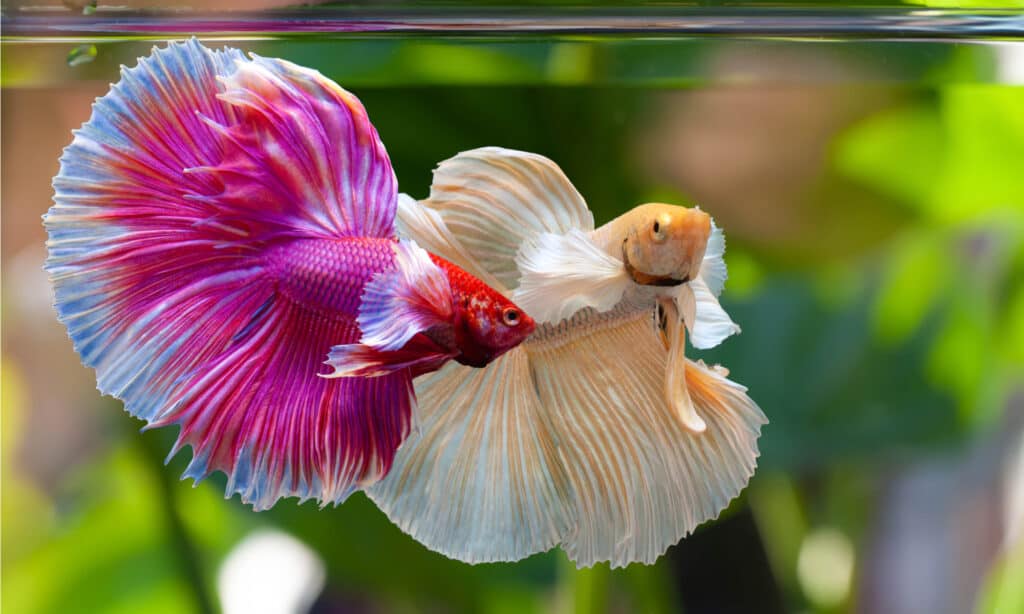
Unlike these Siamese fighting fish, firemouth cichlids are usually peaceful and nonaggressive.
©panpilai paipa/Shutterstock.com
Cichlids as a group have a reputation for being aggressive and territorial. This can make them exciting fish to own, but it may also cause problems in a tank environment. While firemouth cichlids can certainly display aggression, they do so less often than other cichlids. Generally, they are more peaceful and relaxed and won’t attack other fish unless they are provoked.
However, this may change under a couple of conditions. The time for spawning is charged and sometimes difficult. It may trigger an increase in aggression among firemouth cichlids as they compete for mates. The presence of eggs or fry can also have this effect, especially among females. Additionally, if the tank is too small or there are too many fish confined together, a firemouth cichlid’s territorial instincts may be aroused. Male cichlids in particular may bully smaller fish, so it’s best to give them similarly-sized companions. When it comes to male vs female firemouth cichlids, it’s best to gauge whether their environment contains any triggers specific to their sex.
Habitat
Firemouth cichlids are freshwater fish inhabiting several countries throughout Central America. Mexico, Guatemala, and Belize are all home to this vibrant species. In particular, firemouth cichlids inhabit the rivers of Mexico’s Yucatán Peninsula. Slow-moving or still bodies of water like rivers, canals, ponds, lakes, and lagoons provide an ideal environment in the wild.
Firemouth cichlids frequently burrow in the sandy substrate of riverbeds and lakebeds for food. As omnivores, they eat plant matter, small crustaceans, and insects like mosquitoes. They also feed on insect larvae. They may be at risk from attacks by larger fish and birds of prey.
Lifespan
Firemouth cichlids typically live between 8-10 years in captivity. However, under optimal conditions, some individuals can live up to 15 years. In any case, they are pets requiring a fairly long-term commitment. To maximize their lifespan, diligent and meticulous care is necessary.
Like any other pet fish, firemouth cichlids may suffer from a variety of diseases. Ich, or white spot disease, is one of the most common. This condition causes white spots to appear on the fins, body, and gills. Stress is a frequent contributing factor. They may also suffer from swim bladder disorder, a condition causing the displacement of the swim bladder in fish. Dropsy, mouth fungus, and various parasites and bacterial infections are all things to watch out for.
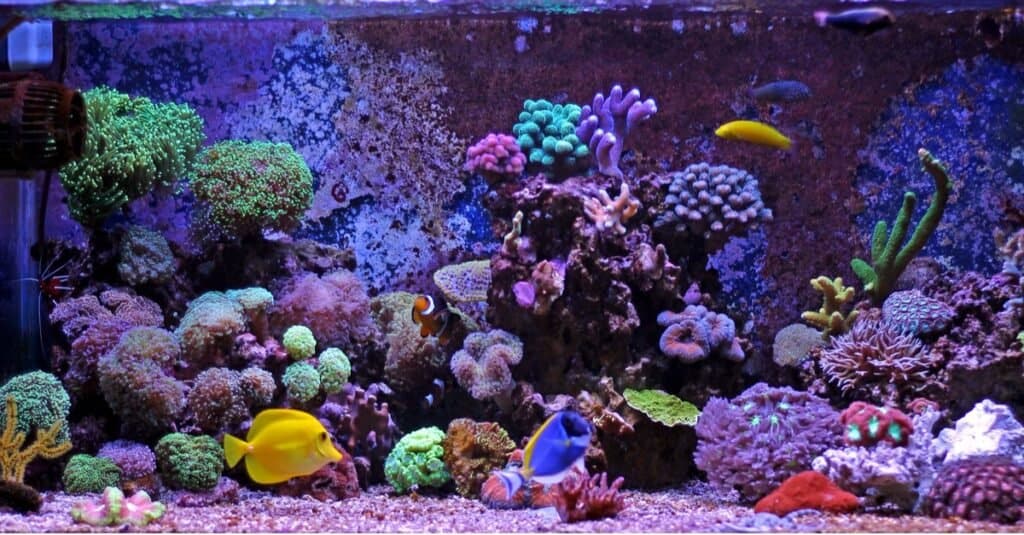
Firemouth cichlids need plenty of space. A 30-gallon tank is the smallest recommended size for one or two cichlids.
©iStock.com/vojce
Pet Care
Firemouth cichlids are easy to care for and typically unaggressive, making them excellent pets for beginners. However, there are a few things necessary to optimize their living conditions. Perhaps most importantly, these fish are at their happiest and healthiest with plenty of room to swim. For one or two cichlids, a 30-gallon aquarium is a good size. For each additional firemouth cichlid, the tank capacity should increase by 5-10 gallons. This will give them plenty of room to claim their own territory and avoid unnecessary confrontations.
It’s important to regulate the water conditions in the tank. An ideal water temperature for this species falls between 75-86°F. The pH levels should be between 6.5 to 8 with a water hardness of 8-15 dH. Plants, driftwood, and rocks will all enhance the environment while giving the fish somewhere to hide.
Although firemouth cichlids are able to coexist peacefully in a group setting, it’s important to keep them with similar-sized fish. They may bully smaller fish or find themselves on the receiving end of aggression from larger, pushier species. Compatible fish species include the rummy nose tetra, the pictus catfish, and the peacock cichlid.
Firemouth cichlids will eat just about anything you feed them. Fish flakes and fresh or frozen fish food like brine shrimp and bloodworms are an excellent basis for a healthy diet. Vegetables like spinach and spirulina make great supplements.
As fairly low-maintenance and generally peaceful fish, firemouth cichlids are a great choice for beginner pet owners. Their beautiful fiery colouring will add a touch of personality to any aquarium.
The photo featured at the top of this post is © iStock.com/User10095428_393
Thank you for reading! Have some feedback for us? Contact the AZ Animals editorial team.



